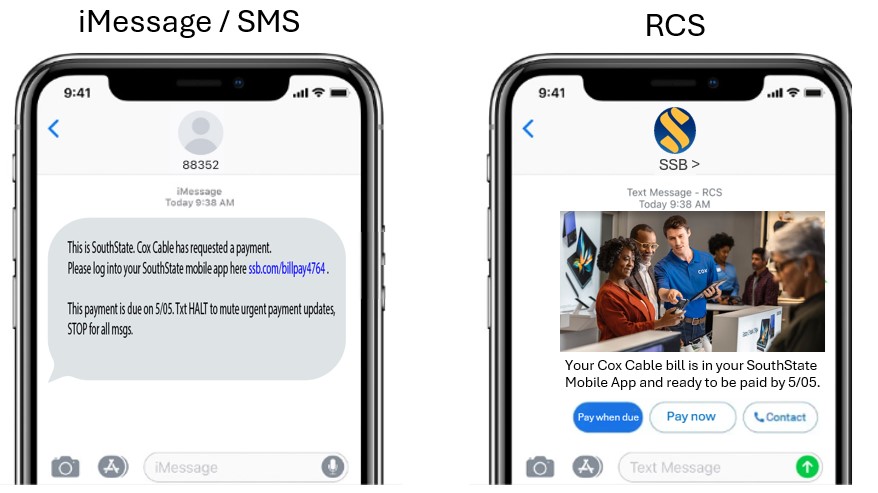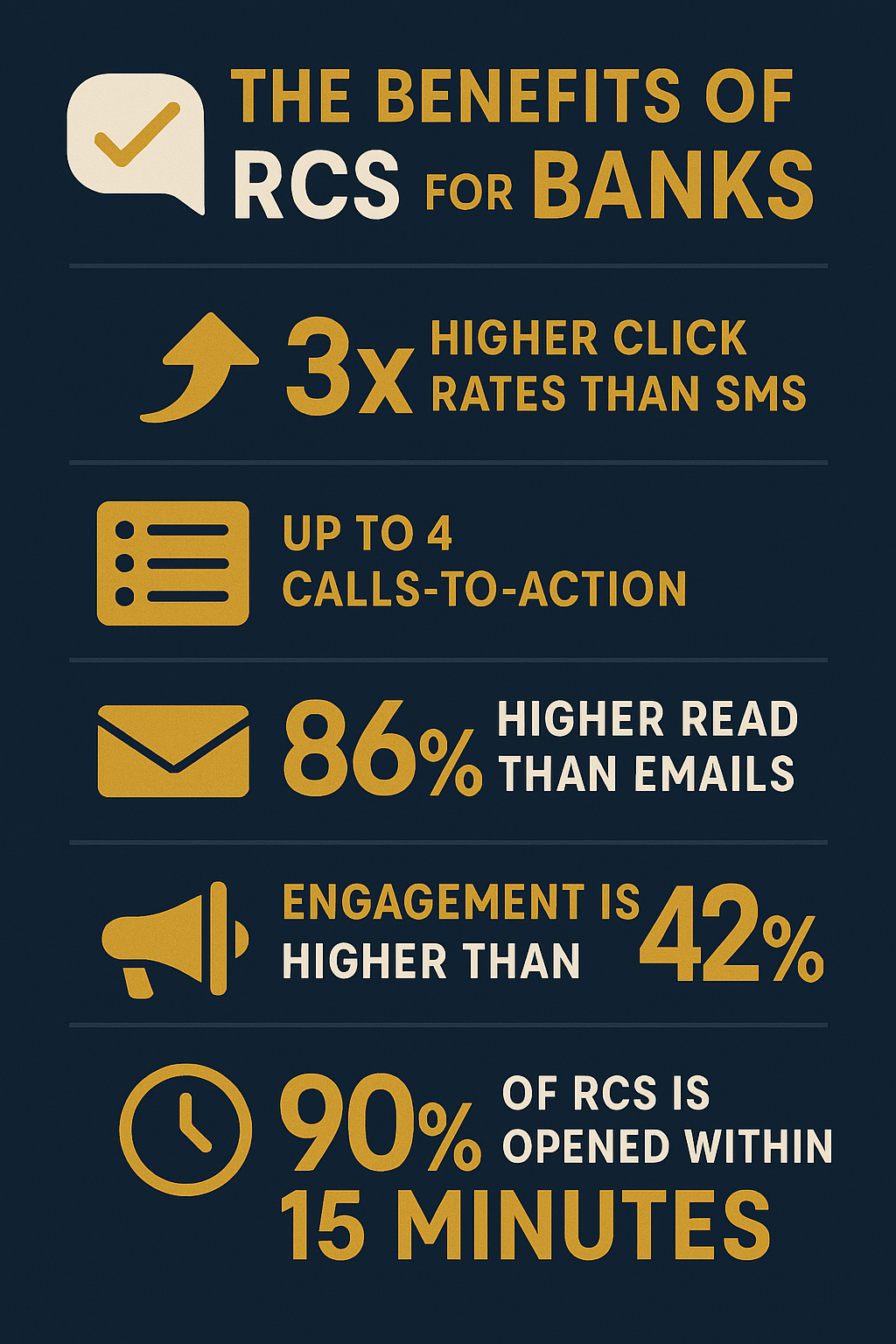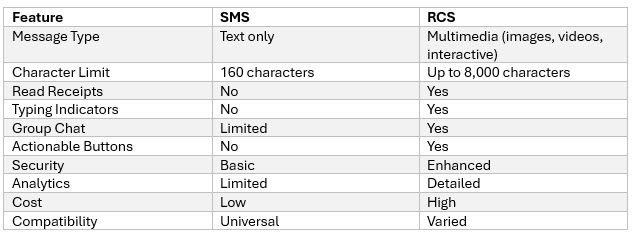Your Bank Marketing Roadmap: Transitioning from SMS to RCS
As of last month, 68% of iPhone users were running iOS 18 or higher and 92% of Android users are running their 5.0 iOS or higher. This means that thanks to recent Apple upgrades in their operating system, most phones are now capable of receiving Rich Communication Services (RCS) messages in addition to traditional SMS. This transformation promises to bring a plethora of benefits and global brands are now gearing up. Banks are now putting RCS on their marketing and product development road map. In this article, we will explore how banks can leverage RCS, the potential risks and rewards involved and provide an analysis between RCS and SMS.
What is Rich Communication Services?
RCS is a new communication protocol that extends the capabilities of traditional SMS. It allows for more interactive and engaging messaging experiences, including features such as group chats, high-resolution images, videos, read receipts and interactive buttons. Essentially, RCS aims to bridge the gap between SMS and modern messaging platforms like WhatsApp and Facebook Messenger, providing a richer and more versatile communication experience.

How Banks Will Use This Enhanced for of Messaging
Banks can utilize this new messaging format in various ways to improve customer interaction and service delivery:
- Enhanced Customer Support: RCS can facilitate more interactive and personalized customer support through multimedia messages, quick reply options, and seamless integration with other services. Popular use cases include request for payments using the instant payment rails (above), loan payments and transaction verification to prevent fraud.
- Marketing and Promotions: Banks can create visually appealing and engaging promotional content, including videos and images, to capture customer attention and drive engagement.
- Transactional Notifications: With RCS, banks can send detailed transaction notifications that include images, clickable links, and actionable buttons, enhancing the user experience.
- Secure Authentication: RCS offers stronger security features compared to SMS, making it a viable option for two-factor authentication and other bank security measures.
- Financial Education: Banks can share educational content, such as tutorials and tips, in an engaging manner through RCS, helping customers make informed financial decisions.
Risks of Moving to RCS
While RCS presents numerous advantages, there are also several risks associated with its adoption:
- Compatibility Issues: RCS is not yet universally supported across all devices and networks. This can lead to inconsistent user experiences and limit its reach. That said, if the end user does not have RCS capabilities, the message automatically fails over to SMS or iMessage ensuring reliable delivery.
- Security Concerns: Despite its enhanced security features, RCS is still susceptible to cyber threats. Banks must ensure robust security measures are in place to protect customer data.
- Cost Implications: While the cost to send an RCS is about the same as an iMessage or SMS, implementing RCS could require an additional vendor increasing complexity and cost. Additionally, training staff to effectively use RCS can incur additional expenses.
- Regulatory Challenges: Banks must navigate complex regulatory environments to ensure compliance with data protection and communication laws when using RCS. The expanded format provides more opportunity to run astray of regulations.
- Customer Adoption: Convincing customers to switch from SMS to RCS can be challenging, as it requires changes in user behavior and preferences.
Rewards of Moving to RCS

Despite the risks, the rewards of adopting this new format can be substantial:
- Security: While not completely secure, Rich Communication Services is encrypted in transit and often end-to-end making it more secure than text and many forms of SMS messages.
- Enhanced Customer Engagement: RCS enables banks to create more interactive and engaging content, leading to higher customer satisfaction, loyalty and data collection.
- Personalization: A Boston Consulting Group survey detailed that 80% of consumers are comfortable, and now expect, some level of personalization. RCS’s power in the ability to deliver 1:1 marketing and customer support.
- Improved Communication Efficiency: With multimedia capabilities and actionable buttons, RCS can streamline communication processes and reduce the time taken to resolve customer queries.
- Brand Differentiation: Banks that adopt this messaging standard can distinguish themselves from competitors by offering a superior communication experience.
- Increased Conversion Rates: Visually appealing and interactive promotional content can lead to higher conversion rates and more effective marketing campaigns.
- Better Analytics: RCS provides detailed analytics on message delivery, read receipts, and customer interactions, enabling banks to optimize their communication strategies.
Comparative Analysis: RCS vs. SMS
To better understand the differences and advantages of RCS over SMS, let’s look at a comparative analysis:

Use Cases
The bulk of the use cases around RCS revolves around better customer service where engagement is important. Here are some of the most popular use cases:
Payments: Interactive RCS messaging offers a lightning-fast, way to enact the growing trend of “request for payment.” Customers enjoy one-click convenience, and companies can provide real-time payment transparency.
Fraud alerts and verification: RCS transforms scam warnings from scary notifications to helpful heroes. Clients can easily verify banking transactions or report suspicious activity through media options in addition to validating transactions.
Bill payment reminders: Forgotten receipts will not bother you anymore. Banks can send supercharged notifications with all the payment info people need, plus a simple click to finish the process. It’s still a bill to pay, but much more convenient.
Onboarding & Engagement: Engaging forms make providing information easier when signing up for a new product particularly for existing customers. RCS often highlight progress bars and status updates in order to provide complete transparency. RCS can be more effective at appointment scheduling, alerts, notifications, basic problem resolution, branch/ATM locators and satisfaction polling.
Sales and Marketing: According to the statistics, people are 35 times more likely to read an messages in this format compared to email, especially when it’s multimedia. Tutorials and guided tours can help customers navigate online banking platforms on the go. Personalized marketing can further enhance marketing lift for promotional emails.
Conclusion
As marketing technology continues to evolve, banks are constantly seeking innovative ways to enhance customer communication. One of the latest advancements in this realm is the adoption of artificial intelligence and machine learning. These technologies allow banks to deliver more personalized and timely communications, ultimately improving customer satisfaction and loyalty.
Rich communication services will serve banks well by dramatically boosting engagement. By leveraging data and predictive analytics, banks can offer tailored product recommendations, personalized offers, and real-time alerts, enhancing the overall customer experience even more.
As these technologies continue to develop, we can expect even more sophisticated and effective methods of customer engagement in the banking industry. The future of customer communication in banking is bright, with endless possibilities for innovation and improvement.

